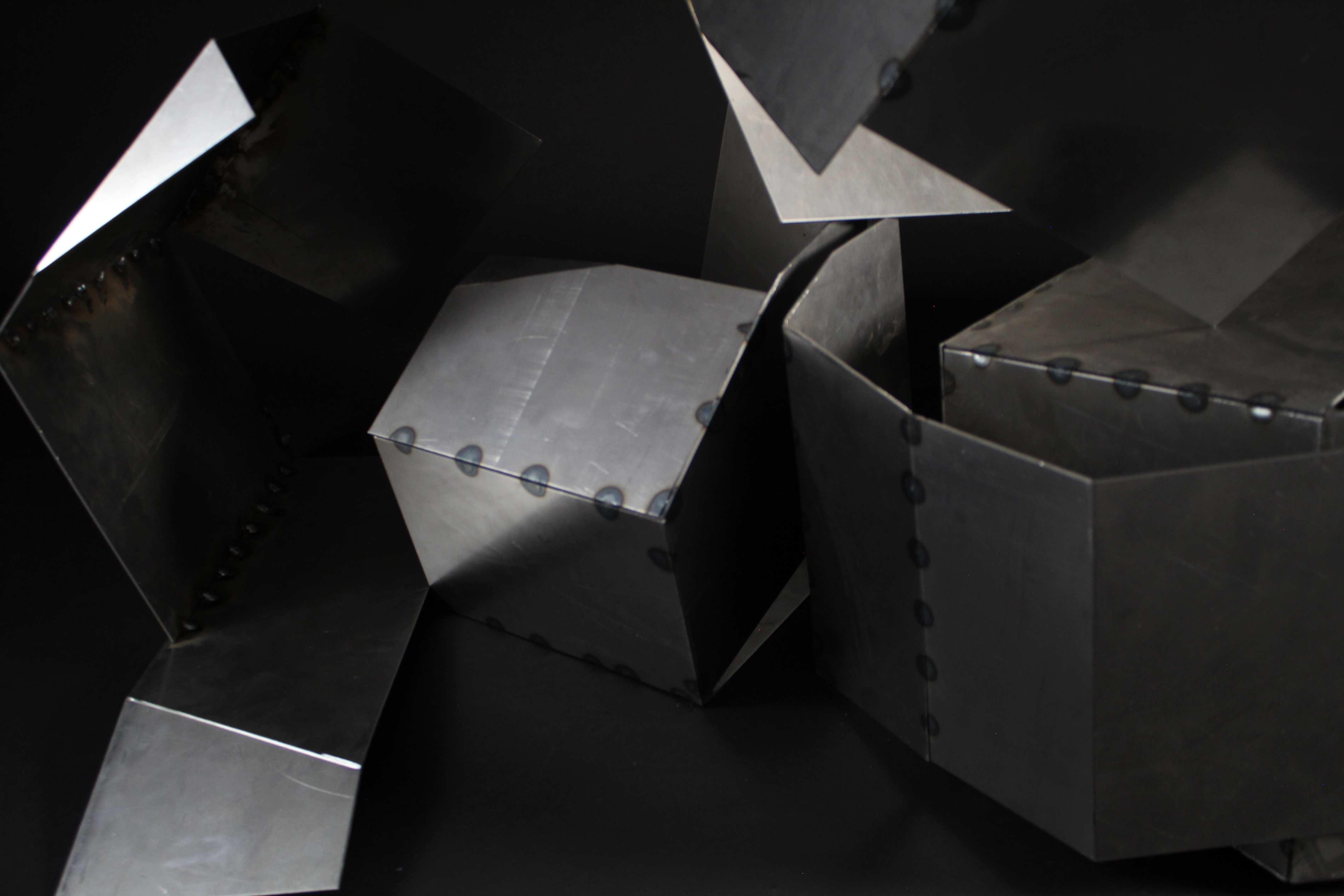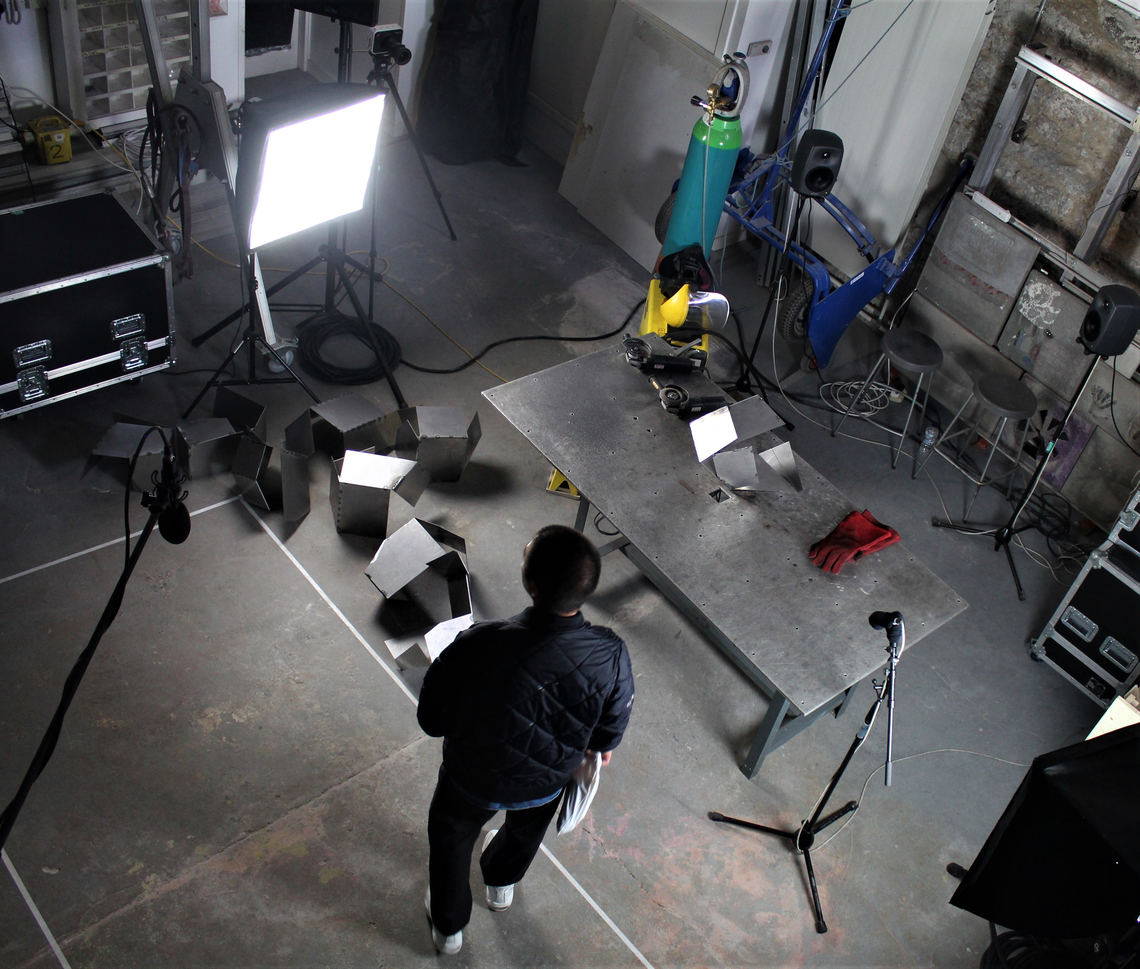4. Reflections
During the installation setup, audience experience involved a closer contact with the iterations of the interactions across material developed during the performance. The previously-made objects presented together with the just-made one that was left on the working bench at the end of each hour, expressed a longer manifestation of the temporal level of co-composing than during the performance, while sound was referred to at that point by audience members as ambient and environmental and as a 'thumbnail sketch' of the performance.
Following the installation-performance, members of the audience were interviewed about their experience during the event and inside the installation space. Some characterised the processed sound as 'invisible sculpting' which, created an interdependent situation between the two modalities. Overall, audience members stated that the relationships between acoustic and electronic sound material varied both throughout single performances and the multiple iterations of the piece. Another observation made was that the impact of the working tools on the sound environment seemed to change according to how I interacted with the software on the computer. Interviewees also stressed that being in the workshop space enhanced both their material and immaterial experience of all the elements of the work by seeing/hearing, which was amplified by the processed soundscape. Some audience members were interacting with the objects by touching or approaching them very closely.
The combination of performance and installation provided with two ways of experiencing co-composition that were complementary to each other: the performance time allowed experiencing the co-compositional relationships, while the installation time revealed the generated material traces. This expanded the work in terms of scale, variation and multiplicity by showing the potential of co-composition in simultaneously experienced spatiotemporal levels through “equating the immediate past with the onrushing future” (Bishop-Stall and Zayne Bussey, 2013). Interviewing audience members did not aim at concretising an experience rather highlighting the personalised views and reflections on the co-compositional situation. The developed interdependent response in this work contributes insights of value to both sonic and sculptural practice: sonic responses enabled treating sculpture in a manner that is temporal, performable and directly informed by the sounds produced and the processed sounds; it used sculptural practice to inform a new approach toward a material-driven aesthetic in sound performance and production; it provided with a novel understanding of the relationships between the two modalities beyond hybrid or dual forms of art as it explored ways and spaces for transition between and across the different types of material.
About
Eleni-Ira Panourgia is an artist working at the intersection of visual and sonic arts and a teaching and research fellow at the University of Paris Est Marne-la-Vallée. She has recently completed her PhD in Art at the University of Edinburgh titled ‘Co-composition processes: form, structure and time across sculpture and sound’. Eleni-Ira works across sculpture, sound and image in a responsive and interactive way in relation to materials and their processes, spaces and technologies. She explores the potential of such complex morphologies within artistic, design and social processes. Eleni-Ira is member of Greek Sculptors’ Association, the Chamber of Fine Arts of Greece, Onassis Scholars' Association, the Research Centre for Creative-Relational Inquiry and RAFT Research Group. She is co-founder of sIREN research network and co-founder and managing editor of Airea: Arts and Interdisciplinary Research Journal.
The PhD research related to this exposition was undertaken in 2015-2019 at the University of Edinburgh and it was funded by the Onassis Foundation and the A.G. Leventis Foundation. Link to publication: ‘Co-composition processes: form, structure and time across sculpture and sound’
Performance 'Process/Procedure' by Eleni-Ira Panourgia, September 2018, University of Edinburgh. Still from video.
Performance 'Process/Procedure' by Eleni-Ira Panourgia, September 2018, University of Edinburgh. Photographed by Jack Walker.
Bibliography
ADAMSON, G. (2007). Thinking through Craft, Oxford: Berg.
BERNSTEIN, D. W. (2015). John Cage's Cartridge Music (1960): ‘A galaxy reconfigured’. Contemporary Music Review, 33(5-6), 556-569.
BISHOP-STALL, R. & ZAYNE BUSSEY, N. (2013). All That Remains: Tracing Time and Performing Process in Contemporary Art [online]. Passenger Art. Available from: https://passengerart.com/2013/04/05/199/ [Accessed 8 November 2018].
BLOW, M. P. (2014). On the simultaneous perception of sound and three-dimensional objects. Thesis (PhD), Oxford Brookes University.
BOTHA, M. (2017). A Theory of Minimalism, London: Bloomsbury.
BUCHLOH, B., H.D. (2007). Richard Serra's Early Work: Sculpture between Labor and Spectacle. IN: MCSHINE, K. & COOKE, L. (eds.) Richard Serra: Sculpture: Fourty Years, New York: The Museum of Modern Art, pp43-60.
CAMILLERI, F. (2013). Between laboratory and institution: Practice as research in no man's land. The Drama Review, 57(1), 152-166.
CANDY, L. & EDMONDS, E. (2018). Practice-Based Research in the Creative Arts: Foundations and Futures from the Front Line. Leonardo, 51(1), 63-69.
CHION, M. (2016). Sound: An Acoulogical Treatise, Translated by STEINTRAGER, J. A., Durham, NC: Duke University Press.
COYNE, R. (2010). The Tuning of Place : Sociable Spaces and Pervasive Digital Media, Cambridge, Mass.: MIT Press.
CROFT, J. (2007). Theses on liveness. Organised Sound, 12(1), 59-66.
DE BRUYN, D. (2013). Materialist Performance in the Digital Age. Screening the Past, 37 [online]. Available from: http://www.screeningthepast.com/2013/09/materialist-performance-in-the-digital-age/ [Accessed 12 July 2018].
DHOMONT, F. (1994). La dialogue du fer et du son. IN: HAHNLOSER-INGOLD, M. (ed.) Oscar Wiggli: Sculptures, dessins, photographies et projets musicaux, Bern: Editions Benteli, pp177-183.
DI SCIPIO, A. (2013-14). Sound Object? Sound Event! Ideologies of Sound and the Biopolitics of Music Soundscape. The Journal of Acoustic Ecology, 13(1), 10-14.
DORMER, P. (1994). The art of the maker: Skill and its meaning in art, London: Thames & Hudson.
FURNISS, P. D. (2018). Present performer: A humanised augmented practice of the clarinet. Thesis (PhD), University of Edinburgh.
GEORGE, H. (2014). The Elements of Sculpture: A Viewer's Guide, London: Phaidon Press.
GRAY, C. & MALINS, J. (2004). Visualizing Research: A guide to the research process in Art and Design, Burlington, Vt.: Ashgate.
HAMRAOUI, E. (2013). Travail vivant, subjectivité et coopération : aspects philosophiques et institutionnels. Nouvelle Revue de Psychosociologie, 15, 59-76.
HOFER, S. (2014). ‘Atomic’ Music: Navigating experimental electronica and sound art through microsound. Organised Sound, 19(3), 295 - 303.
HOFFMAN, B. (2012). The Time of Live Art. IN: HEDDON, D. K., JENNIE (ed.) Histories and Practices of Live Art, Basingstoke: Palgrave Macmillan, pp37-64.
INGOLD, T. (2000). The Perception of the Environment: Essays on livelihood, dwelling and skill. Taylor and Francis. [Online version accessed from ProQuest Ebook Central, 2 February 2018, https://ebookcentral.proquest.com/lib/ed/detail.action?docID=166183].
INGOLD, T. (2009). The Textility of Making. Cambridge Journal of Economics, 34(1), 91-102.
INGOLD, T. (2013). Making: Anthropology, archaeology, art and architecture, London: Routledge.
KELLY, C. (2018). Materials of Sound: Sound as (More Than) Sound. Journal of Sonic Studies, 16. [online]. Available from: https://www.researchcatalogue.net/view/456784/456785 [Accessed 9 May 2018].
KLEE, P. (1973). Paul Klee Notebooks: Volume 2: The nature of nature, London: Lund Humphries.
LUBIN-LEVY, J., & SHVARTS, A. (2016). Living Labor: Marxism and Performance Studies. Women & Performance: A Journal of Feminist Theory, 26(2–3), 115-121.
MOMA (n.d.). Serra discusses To Lift. MoMA Learning [online]. Available from: https://www.moma.org/learn/moma_learning/richard-serra-to-lift-1967 [Accessed 4 October 2017].
MORRIS, R. (1970). Some notes on the phenomenology of making: The search for the motivated, Artforum, 8(8), 62-66.
MORRIS, R. (1993). Continuous Project Altered Daily: The Writings of Robert Morris, Cambridge, Mass. and London: MIT Press.
NELSON, R. (2013). Practice as Research in the Arts: Principles, Protocols, Pedagogies, Resistances, Basingstoke: Palgrave Macmillan.
PANOURGIA, E.-I. (2016). Spectrogram Data as System for Making Sculpture. IN: SODDU, C., ed. 19th Generative Art Conference GA2016, 2016, Florence, Italy, pp179-199.
PÉREZ, S. R. (2011). Towards an ecology of making. IN: BORDEN, G. P. & MEREDITH, M. (eds.) Matter: Material Processes in Architectural Production, Abingdon: Routledge, pp379-396.
PHELAN, P. (1993). The ontology of performance: Representation without reproduction. IN: Unmarked: The Politics of Performance, London and New York: Routledge, pp146-166.
RAJCHMAN, J. (2007). Serra's Abstract Thinking. IN: MCSHINE, K. & COOKE, L. (eds.) Richard Serra: Sculpture: Fourty Years, New York: The Museum of Modern Art, pp61-76.
REITER, E., RUTZ, H. H. & NIERHAUS, G. (2015). Eva Reiter/Wire Tapping the Machine. IN: NIERHAUS, G. (ed.) Patterns of Intuition [online]. Springer, Dordrecht. Available from: https://www.springer.com/gp/book/9789401795609 [Accessed 12 November 2019].
SANDEN, P. (2013). Liveness in Modern Music Musicians, Technology, and the Perception of Performance, New York: Routledge.
SAUNDERS, J. (2011). Testing the Consequences—Multipart Series in the Work of the Wandelweiser Composers. Contemporary Music Review, 30(6), 497-524.
SERRA, R. (2000). Richard Serra: Tools & Strategies | "Exclusive" | Art21 [online]. Available from: https://www.youtube.com/watch?v=G-mBR26bAzA [Accessed 28 September 2017].
SMALLEY, D. (1986). Spectro-morphology and Structuring Processes. IN: EMMERSON, S. (ed.) The Language of Electroacoustic Music, Basingstoke: Macmillan, pp61-93.
SØCHTING, R. (2017). Diagram for Invisibility. Seismograf, (November 2017). [online]. Available from: http://seismograf.org/fokus/sound-art-matters/diagram-for-invisibility [Accessed 7 November 2018].
STEIER, F. (1992). Research and reflexivity, Thousand Oaks, CA: Sage Publications.
TEST DEPT (2014). History [online]. Available from: https://testdept.org.uk/history [Accessed 31 January 2018].
VELASCO-PUFLEAU, L. (2017). Listening to the sounds of war: an Interview with Michel Chion. Sound Studies, 3(2), 165-169.
Artworks cited
Beuger, A. (2000). cadmiumgelb [CD, EW01.076]. Haan: Edition Wandelweiser Records.
Blow, M. (2011). Bleigiessen (Bending Time) [Metal sculpture with sound]. Available from: https://radar.brookes.ac.uk/radar/items/e307eecc-8abc-4b62-a4fe-9e43f632a3c0/1/ [Accessed 20 November 2019].
Cage, J. (1952). Water Music [Musical score, EP 6770]. New York: Peters Edition.
Hespos, H-J. (1982). Selltanz (Tightrope Dance) [CD, 999 245-2]. Georgsmarienhütte: cpo.
Fontana, L. (1950). Concetto spaziale (spatial concept) 50B9, [Iron]. Milan: Fondazione Lucio Fontana.
Pope, G. (2010). Cipher Screen [Live performance]. Available from: https://gregpope.org/cipher-screen/ [Accessed: 28 November 2019].
Morris, R. (1961). Box With the Sound of Its Own Making, [Wooden box, internal speaker and 7” cassette of ¼” tape]. Available from: http://art.seattleartmuseum.org/objects/11616/box-with-the-sound-of-its-own-making?ctx=366357b3-6695-49a3-a3fd-15482b8764e5&idx=1 [Accessed: 30 November 2019].
Serra, R. (1967-68). Verb List Compilation: Actions to Relate to Oneself [Pencil on two sheets of paper]. Available from: https://www.moma.org/collection/works/152793 [Accessed: 1 December 2019].
Serra, R. (1967). To Lift [Vulcanized rubber]. Available from: https://www.moma.org/collection/works/101902 [Accessed: 1 December 2019].
Wiggli, O. (1994). RESEMBLANCES ET MIROITEMENTS [Musical score]. Muriaux: Fondation Oscar et Janine Wiggli.


